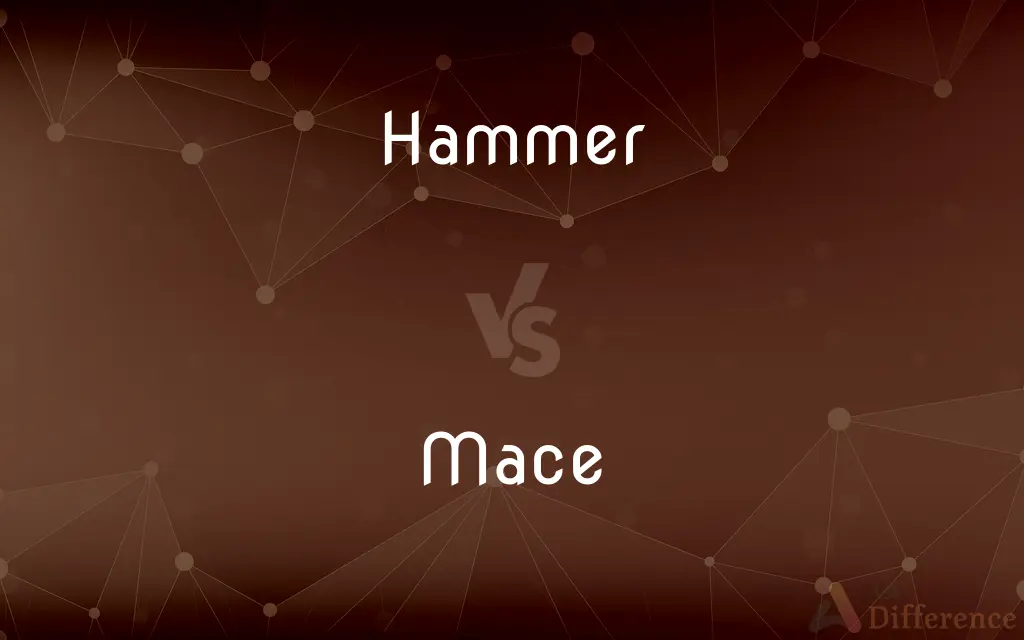Hammer vs. Mace — What's the Difference?
By Maham Liaqat & Fiza Rafique — Updated on April 3, 2024
A hammer is a tool designed for delivering powerful blows, primarily to drive nails, while a mace is a medieval weapon intended for combat.

Difference Between Hammer and Mace
Table of Contents
ADVERTISEMENT
Key Differences
A hammer is essentially a tool used in various construction and woodworking tasks, characterized by its flat head used for driving nails into wood. On the other hand, a mace is a weapon from the medieval era, designed with a heavy head on a solid shaft used to deliver powerful blows to an opponent in battle.
Hammers are designed with functionality in mind, typically featuring a claw on the back of the head for removing nails, whereas maces were built purely for combat, often adorned with flanges or knobs to penetrate armor.
While hammers are widely used today in both professional settings and home improvement projects, maces have largely become historical artifacts or ceremonial items, reflecting their origins in warfare and knighthood ceremonies.
The versatility of the hammer extends beyond just driving nails; it can also be used for breaking apart materials, fitting parts, and forging metal. In contrast, the mace’s utility is more singular, primarily focused on combat effectiveness, with little use outside of historical reenactment or collection.
Materials and design of hammers vary widely, from simple wooden handles with metal heads to sophisticated, ergonomically designed models for specific tasks. Maces, however, were traditionally made from metal or wood, with a heavy head to maximize impact force, showing less variation in design.
ADVERTISEMENT
Comparison Chart
Primary Use
Driving nails, fitting parts, and demolition
Combat, specifically for bludgeoning
Design Features
Claw for nail removal, ergonomic handles
Flanged or spiked heads for armor penetration
Historical Context
Tools for construction since ancient times
Medieval weapon for knights and warriors
Material Variations
Wood, metal, fiberglass handles; metal heads
Mostly metal, some with wood or leather grips
Current Relevance
Essential tool in construction and DIY
Mostly historical or ceremonial use
Compare with Definitions
Hammer
An instrument for breaking up things.
She used a hammer to crack open the walnuts.
Mace
A medieval combat weapon with a heavy head.
The knight brandished his mace before the battle.
Hammer
A tool with a heavy, flat head attached to a handle.
The carpenter’s hammer was well-worn from use.
Mace
An item used in ceremonies symbolizing authority.
The ceremonial mace is carried during official processions.
Hammer
A tool for delivering blows to an object.
He used a hammer to drive the nail into the board.
Mace
A bludgeoning tool with a solid shaft.
The guard held a mace by the gate.
Hammer
A tool with various uses in different trades.
The jeweler used a tiny hammer for delicate work.
Mace
A weapon designed to break through armor.
His mace was effective against the armored soldiers.
Hammer
A device for shaping metal by striking.
The blacksmith wielded his hammer with precision.
Mace
A historical weapon now seen in museums.
The museum’s medieval collection includes a well-preserved mace.
Hammer
A hammer is a tool, most often a hand tool, consisting of a weighted "head" fixed to a long handle that is swung to deliver an impact to a small area of an object. This can be, for example, to drive nails into wood, to shape metal (as with a forge), or to crush rock.
Mace
A staff of office, especially that which lies on the table in the House of Commons when the Speaker is in the chair, regarded as a symbol of the authority of the House.
Hammer
A hand tool consisting of a handle with a head of metal or other heavy rigid material that is attached at a right angle, used for striking or pounding.
Mace
A heavy club with a spiked metal head.
Hammer
The part of a gunlock that hits the primer or firing pin or explodes the percussion cap and causes the gun to fire.
Mace
The reddish fleshy outer covering of the nutmeg, dried as a spice.
Hammer
(Music) One of the padded wooden pieces of a piano that strikes the strings.
Mace
Spray (someone) with Mace
Three individuals were Maced by an unknown male
Hammer
A part of an apparatus that strikes a gong or bell, as in a clock.
Mace
A ceremonial staff borne or displayed as the symbol of authority of a legislative body.
Hammer
(Anatomy) See malleus.
Mace
A macebearer.
Hammer
(Sports) A metal ball weighing 16 pounds (7.2 kilograms) and having a long wire or wooden handle by which it is thrown for distance in track-and-field competition.
Mace
A heavy medieval war club with a spiked or flanged metal head, used to crush armor.
Hammer
A small mallet used by auctioneers.
Mace
A thin fleshy red covering that surrounds the kernel of the nutmeg, dried and used as a spice.
Hammer
To hit, especially repeatedly, with a hammer; pound.
Mace
A heavy fighting club.
Hammer
To strike forcefully and repeatedly
Hooves hammering the ground.
Mace
A ceremonial form of this weapon.
Hammer
To assault with military force
Hammered the position with artillery shells.
Mace
A long baton used by some drum majors to keep time and lead a marching band. If this baton is referred to as a mace, by convention it has a ceremonial often decorative head, which, if of metal, usually is hollow and sometimes intricately worked.
Hammer
To beat into a shape with a hammer or similar tool
Hammered the metal into a goblet.
Mace
An officer who carries a mace as a token of authority.
Hammer
To accomplish or produce with difficulty or effort. Often used with out
Hammer out an agreement.
Mace
A knobbed mallet used by curriers make leather supple when dressing it.
Hammer
To put together, fasten, or seal, particularly with nails, by hammering.
Mace
(archaic) A billiard cue.
Hammer
To force upon (someone) by constant repetition
Hammered the information into the students' heads.
Mace
An old money of account in China equal to one tenth of a tael.
Hammer
To cause harm, loss, or difficulty to (someone), especially repeatedly
Investors hammered in the bear market.
Mace
An old weight of 57.98 grains.
Hammer
To defeat soundly
Got hammered in the playoffs.
Mace
A spice obtained from the outer layer of the kernel of the fruit of the nutmeg.
Hammer
To attack verbally
A politician hammered in the press.
Mace
Tear gas or pepper spray, especially for personal use.
Hammer
To deal repeated blows with or as if with a hammer; pummel
"Wind hammered at us violently in gusts" (Thor Heyerdahl).
Mace
To hit someone or something with a mace.
Hammer
To undergo beating in the manner of a hammer
My pulse hammered.
Mace
To spray in defense or attack with mace (pepper spray or tear gas) using a hand-held device.
Hammer
(Informal) To keep at something continuously. Often used with away
Hammered away at the problem.
Mace
(informal) To spray a similar noxious chemical in defense or attack using an available hand-held device such as an aerosol spray can.
Hammer
A tool with a heavy head and a handle used for pounding.
Bobby used a hammer and nails to fix the two planks together
Mace
A money of account in China equal to one tenth of a tael; also, a weight of 57.98 grains.
Hammer
The act of using a hammer to hit something.
The nail is too loose—give it a hammer.
Mace
A kind of spice; the aril which partly covers nutmegs. See Nutmeg.
Hammer
(firearms) A moving part of a firearm that strikes the firing pin to discharge a gun.
Mace
A staff borne by, or carried before, a magistrate as an ensign of his authority.
Hammer
(anatomy) The malleus, a small bone of the middle ear.
Mace
An officer who carries a mace as an emblem of authority; a macebearer.
Hammer
(music) In a piano or dulcimer, a piece of wood covered in felt that strikes the string.
The sound the piano makes comes from the hammers striking the strings
Mace
A knobbed mallet used by curriers in dressing leather to make it supple.
Hammer
(sports) A device made of a heavy steel ball attached to a length of wire, and used for throwing.
Mace
A rod for playing billiards, having one end suited to resting on the table and pushed with one hand.
Hammer
(curling) The last stone in an end.
Mace
A chemical preparation containing tear gas in a solvent, packaged in the form of a spray, and used to temporarily incapacitate people, such as rioters or criminals, by causing intense eye and skin irritation; also called chemical mace. It is designed to be a non-lethal weapon for defending against violent people.
Hammer
(frisbee) A frisbee throwing style in which the disc is held upside-down with a forehand grip and thrown above the head.
Mace
(trademark) a liquid that temporarily disables a person; prepared as an aerosol and sprayed in the face, it irritates the eyes and causes dizziness and immobilization
Hammer
Part of a clock that strikes upon a bell to indicate the hour.
Mace
An official who carries a mace of office
Hammer
One who, or that which, smites or shatters.
St. Augustine was the hammer of heresies.
Mace
Spice made from the dried fleshy covering of the nutmeg seed
Hammer
(journalism) hammer headline
Mace
A ceremonial staff carried as a symbol of office or authority
Hammer
(motor racing) The accelerator pedal.
Hammer
To strike repeatedly with a hammer, some other implement, the fist, etc.
Hammer
To form or forge with a hammer; to shape by beating.
Hammer
(figuratively) To emphasize a point repeatedly.
Hammer
To hit particularly hard.
Hammer
To ride very fast.
Hammer
(intransitive) To strike internally, as if hit by a hammer.
I could hear the engine’s valves hammering once the timing rod was thrown.
Hammer
To defeat (a person, a team) resoundingly
We hammered them 5-0!
Hammer
To make high demands on (a system or service).
Hammer
To declare (a person) a defaulter on the stock exchange.
Hammer
To beat down the price of (a stock), or depress (a market).
Hammer
An instrument for driving nails, beating metals, and the like, consisting of a head, usually of steel or iron, fixed crosswise to a handle.
With busy hammers closing rivets up.
Hammer
Something which in form or action resembles the common hammer
He met the stern legionaries [of Rome] who had been the "massive iron hammers" of the whole earth.
Hammer
A spherical weight attached to a flexible handle and hurled from a mark or ring. The weight of head and handle is usually not less than 16 pounds.
Hammer
To beat with a hammer; to beat with heavy blows; as, to hammer iron.
Hammer
To form or forge with a hammer; to shape by beating.
Hammer
To form in the mind; to shape by hard intellectual labor; - usually with out.
Who was hammering out a penny dialogue.
Hammer
To be busy forming anything; to labor hard as if shaping something with a hammer.
Whereon this month I have been hammering.
Hammer
The part of a gunlock that strikes the percussion cap when the trigger is pulled
Hammer
A hand tool with a heavy rigid head and a handle; used to deliver an impulsive force by striking
Hammer
An athletic competition in which a heavy metal ball that is attached to a flexible wire is hurled as far as possible
Hammer
The ossicle attached to the eardrum
Hammer
A heavy metal sphere attached to a flexible wire; used in the hammer throw
Hammer
A striker that is covered in felt and that causes the piano strings to vibrate
Hammer
A power tool for drilling rocks
Hammer
The act of pounding (delivering repeated heavy blows);
The sudden hammer of fists caught him off guard
The pounding of feet on the hallway
Hammer
Beat with or as if with a hammer;
Hammer the metal flat
Hammer
Create by hammering;
Hammer the silver into a bowl
Forge a pair of tongues
Common Curiosities
Can a hammer be used as a weapon?
While not designed as a weapon, a hammer can be used as one due to its heavy, solid construction.
What are the key design differences between a hammer and a mace?
Hammers often feature a claw for nail removal, while maces have heavy, often spiked heads for combat.
Why do hammers have a claw on the back?
The claw is designed for removing nails from wood or other materials.
What materials are hammers made from?
Hammers are made from a variety of materials, including wood, metal, and fiberglass.
Are maces still used today?
Maces are mostly ceremonial or collectible items today, with no practical use in combat.
Do maces have any symbolic meaning?
Historically, maces symbolize authority and power, often used in ceremonial contexts.
What are some modern uses of the hammer?
Modern uses of the hammer include home improvement, construction projects, and metalworking.
How has the use of hammers evolved over time?
Hammers have remained relatively consistent in use, mainly for construction, craftsmanship, and demolition.
How do collectors view medieval maces today?
Medieval maces are valued as historical artifacts, often sought after by collectors and historians.
What is the primary difference between a hammer and a mace?
A hammer is a tool for driving nails and breaking apart materials, whereas a mace is a medieval weapon for combat.
Were maces effective against armor?
Yes, maces were designed to deliver powerful blows that could damage or penetrate armor.
How do hammers contribute to safety in their use?
Hammers are designed with ergonomic handles and materials to minimize injury and ensure a safe grip during use.
What was the primary battlefield role of a mace?
The mace was primarily used for close combat, particularly against armored opponents.
Are there different types of hammers for specific tasks?
Yes, there are many types of hammers designed for specific tasks, including sledgehammers, claw hammers, and ball-peen hammers.
Is the design of the mace influenced by its intended use?
Yes, the heavy head and solid shaft of a mace are specifically designed for combat effectiveness.
Share Your Discovery

Previous Comparison
Tartness vs. Acidity
Next Comparison
Assurance vs. SuretyAuthor Spotlight
Written by
Maham LiaqatCo-written by
Fiza RafiqueFiza Rafique is a skilled content writer at AskDifference.com, where she meticulously refines and enhances written pieces. Drawing from her vast editorial expertise, Fiza ensures clarity, accuracy, and precision in every article. Passionate about language, she continually seeks to elevate the quality of content for readers worldwide.















































